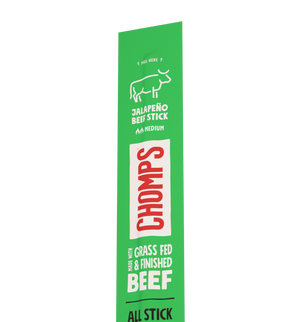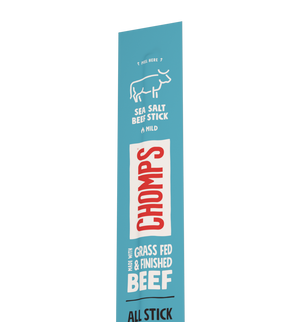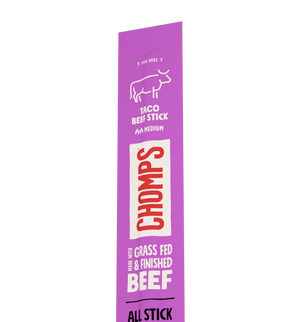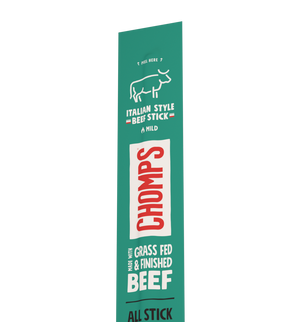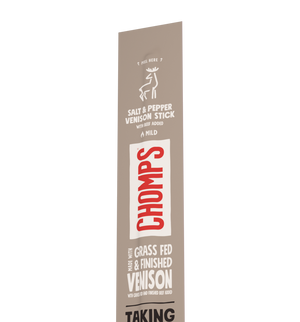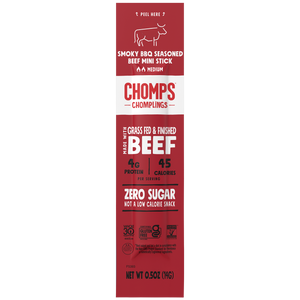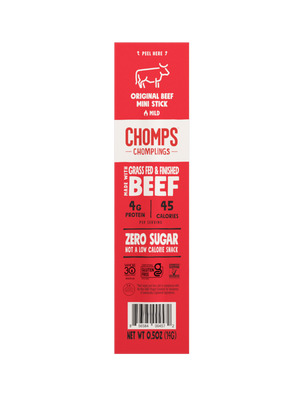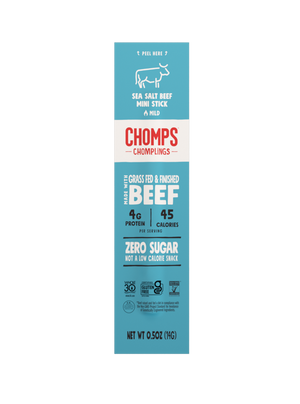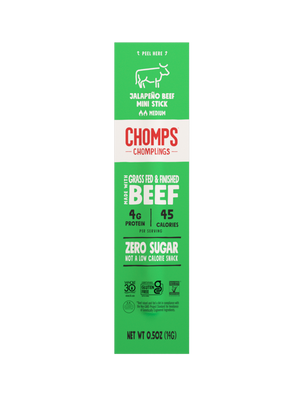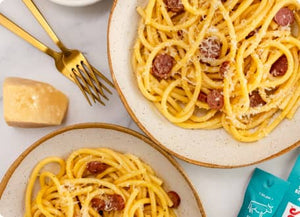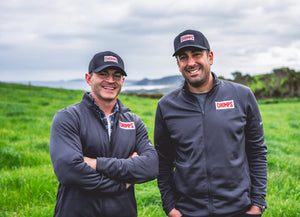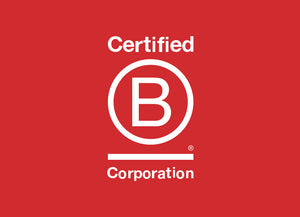Keeping your kitchen and pantry well-stocked with ingredients for meals and snacks makes sticking with the Paleo diet easier and more successful long-term.
The Paleo diet is made up of unprocessed foods. The following foods are included on the Paleo diet:
- Meat
- Poultry
- Seafood
- Eggs
- Vegetables
- Fruits
- Nuts
- Seeds
- Herbs
- Healthy fats like coconut oil, extra virgin olive oil, and avocado oil
The following foods are limited or eliminated on the paleo diet:
- Dairy products
- Grains, including wheat, rice, and corn
- Legumes, like beans and lentils
- Sugar
- Processed foods
While many Paleo-approved foods are perishable items like meat and produce, we’ve created a list of pantry items to add to your grocery list. Here are some of our favorite, flavor-packed Paleo pantry staples.
Beef Jerky

The #1 paleo snack to have in your pantry at all times is beef jerky meat sticks! It’s both a great snack and a great addition to any meal. Chomps Original Beef Jerky Sticks weigh in at just 100 calories. And with 10 grams of protein per stick, they can be a great protein supplement to any meal, helping you to stay fueled and full.
Canned Tomatoes
It’s a complete myth that canned produce is nutritionally inferior to fresh fruits and vegetables. While the heat and pressure of canning can destroy some nutrients, canned tomatoes are still a good source of fiber, vitamin C, and lycopene.
Homemade sauces or soups made with canned crushed, diced, or whole tomatoes come together faster, easier. Oftentimes dishes with canned tomatoes are more flavorful compared to cooking with fresh tomatoes.
Grain-Free Flours
Almond flour and coconut flour are examples of grain-free flours that can be enjoyed as part of a Paleo lifestyle. Although moderation is still recommended for Paleo versions of baked goods and sweets, these flours are great to keep on hand when the urge to bake hits.
These flours are lower in carbohydrates and higher in fiber, protein, and fat than wheat flours. Almond and coconut flour contain a high amount of fat, therefore they should be stored in the refrigerator to prevent rancidity and help them last longer.
Assorted Nuts & Nut Butters
Whether you reach for almonds, cashews, pecans, walnuts, or peanuts, nuts are full of healthy fat, protein, and fiber. They’re also a good source of vitamins and minerals, including vitamin E, magnesium, zinc, and selenium.
Choose raw nuts over roasted and natural nut butters. Roasted nuts and prepared trail mixes often contain added PUFA oil(s), sugar, and salt. Look for a natural nut butter that contains just nuts and no added oils or sugar.
You can use whole nuts to make your own nut butters, granola, and snack mixes. Or add them to baked goods, or for topping salads and smoothie bowls. Use ground nut butters to add fat to smoothies, as a vegetable dip, or to flavor savory sauces.
Condiments & Vinegars
Condiments and vinegars can be used to maximize the flavor of your recipes. They can transform plain protein and veggies into a variety of cuisines.
If you like spicy food, keep sriracha, salsa, and hot sauce on hand. For Asian-inspired recipes, tamari, coconut aminos, and fish sauce add umami for depth of flavor.
Vinegar is essential for making your own salad dressings, but they can do way more than that. Try adding a splash of acid to soups and sauces just before serving is a classic chef’s trick to help brighten and unify flavors. Consider apple cider, white wine, red wine, and balsamic varieties.
Some prepared condiments, like ketchup, salad dressings, and mayonnaise are sources of hidden sugar, oils, and/or preservatives that aren’t Paleo-friendly. You can find Paleo versions that are made without sugar and with healthier oils, like avocado oil, or you can try making your own.
Cooking Oils
Cooking with healthy fats that contain a more optimal ratio of omega-3 to omega-6 fatty acids is a key principle of the Paleo diet.
Canola and vegetable oils, which are high in omega-6 fatty acids, should be avoided.
Avocado, coconut, and extra virgin olive oils can be used to bake, saute, and roast. Ghee, or clarified butter, and lard can also be used for most cooking methods.
Dates, Honey & Maple Syrup
Sugar isn’t consumed on a paleo diet, but that doesn’t mean you’ll never taste something sweet again. You can find Paleo recipes for cakes, cookies, and more made with healthier flours and sweeteners like dates, honey, and maple syrup.
Dried dates can be enjoyed by themselves as a sweet treat. Honey and maple syrup can be used to make energy balls or add a touch of sweetness to smoothies, homemade salad dressings, and even savory dishes.
Although they still contain sugar, dates also provide fiber and raw honey and maple syrup contain antioxidants and trace minerals.
Olives
A few briny olives right out of the jar are a good Paleo-friendly fix when you’re craving a salty snack. You can also enjoy them on salads, in sauces, or ground into a savory spread like tapenade. Olives are rich in heart-healthy monounsaturated fats and vitamin E.
Turkey Mini Jerky Sticks
We can’t say it enough, jerky sticks are a great pantry essential. Chomps Turkey Mini Jerky Sticks are sized just-right to keep in the car, your bag, or even kids lunchboxes for easy on-the-go snacking.
For more Paleo snack ideas, check out all the other varieties of jerky sticks.


